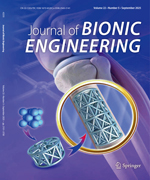This paper introduces a flight simulation of an ornithopter (flapping-wing air vehicle) based on the flexible multi-body dynamics, a refined flapping-wing aerodynamic model and the fluid-structure interaction approach. A simulated ornithopter was modeled using the multi-body dynamics software, MSC.ADAMS, where the flexible parts can be included by importing a finite element model built in the finite element analysis software, ANSYS. To model the complex aerodynamics of flapping-wing, an improved version of modified strip theory was chosen. The proposed integrative simulation framework of ornithopter was validated by the wind tunnel test data reported in the literature. A magpie-sized model ornithopter was numerically designed and simulated to have the longitudinal trim flight condition. We observed a limit-cycle-oscillation of flight state variables, such as pitch attitude, altitude, flight speed, during the trimmed flight of the model ornithopter. Under the trimmed condition of free flight of the model ornithopter, we fixed all the degrees of freedom at the center of gravity to measure the constraint forces and moment. The concept of the “zero moment point” is introduced to explain the physics of ornithopter trimmed longitudinal flight.

 Table of Content
Table of Content
 Table of Content
Table of Content